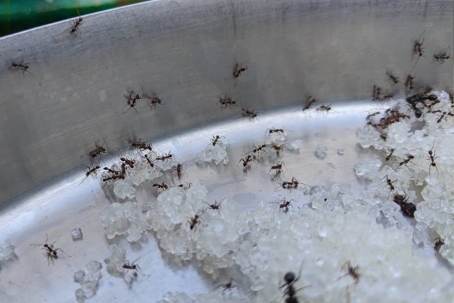What Can Little Black Ants Eat?
Little black ants (Monomorium carbonarium) are highly opportunistic feeders. They’ll take advantage of almost any food source they can find, which is why they show up in kitchens, break rooms, and around moisture. Here’s what they commonly eat:
Sugary Foods (their top choice)
They’re especially attracted to:
Spilled soda or juice
Fruits (fresh or overripe)
Syrups, honey, jams, jellies
Candy or baked goods
Sugar granules or sweet residues on counters
Grease & Oils
They readily feed on:
Bacon grease
Cooking oils
Meat drippings
Oily food packaging
Proteins
They will consume:
Meat scraps
Pet food
Dead insects
Protein-rich pantry items
Plant Material
Outdoors they may eat:
Seeds
Plant secretions
Nectar
Moisture & Decaying Organic Matter
They’re drawn to:
Rotting wood
Damp kitchen areas
Compost or food waste
Little black ants forage in long, persistent trails. Colonies often have multiple nest sites (inside and outside). They can nest in wall voids, decaying wood, soil, or under stones.
What Do Little Black Ants Eat?
Little black ants will eat just about anything, but they show clear, consistent preferences when given options.
1. Sugars — their strongest attraction
This is their number one choice. They’re highly drawn to:
Sweet liquids (syrup, juice, soda)
Honey or jam
Overripe fruit
Sugary residues on counters or floors
Why: Sugars provide quick, easily accessible energy for workers and the colony.
2. Grease & Oils — a close second
They readily seek out:
Cooking oils
Meat drippings
Greasy pans or wrappers
Why: Fats are valuable for brood development and long-term energy.
3. Proteins — especially when brood are present
They’ll feed on:
Meat scraps
Dead insects
Pet food
Why: Protein supports larval growth.
If you rank it by what they choose first when multiple food types are available, the order is usually: Sweet > Grease/Oil > Protein.
Do Little Black Ants Eat Insects?
Little black ants are small, but they’re capable scavengers and will readily feed on other insects—especially ones that are already dead or weakened. They don’t typically hunt aggressively like larger ant species, but they do exploit easily available insect protein.
Soft-bodied insects (their easiest targets)
They take these most frequently because they’re easy to break down:
Aphids (dead or dying)
Termite swarmers that have fallen to the ground
Small caterpillars or larvae of various insects
Dead or injured insects of many types
Scavenging makes up most of their insect intake. Common finds include:
Honeydew-producing insects (not eaten but “farmed”)
They don’t generally eat these insects, but they depend on their sugary secretions:
Mealybugs
Scale insects
This relationship often keeps little black ants near plants and shrubs with infestations.
Little black ants rarely overpower healthy, mobile insects. Instead, they scavenge, clean up dead insects, and harvest protein when it’s readily accessible.
Do Little Black Ants Eat Animals?
Little black ants don’t typically attack or consume large living animals, but they do feed on a variety of very small animals when they can scavenge them:
Carrion (tiny bits of animal remains)
They’ll scavenge:
Small pieces of dead vertebrates (only very soft tissue)
Pet food, which they treat as an animal protein source
What They Don’t Eat
They do not prey on healthy vertebrates (mice, reptiles, birds).
They do not consume living animals larger than tiny invertebrates.
Do Little Black Ants Eat Plants?
Little black ants don’t typically eat plant tissue directly, but they are strongly associated with certain plants because of the food resources those plants provide or attract. Their relationship with plants is mostly indirect. Here’s what they actually use or consume from plants:
Honeydew From Plant-Feeding Insects (their main plant-related food source)
They absolutely rely on sugary honeydew produced by:
Aphids
Mealybugs
Scale insects
Whiteflies
They don’t eat the plants, but they harvest the honeydew and even protect these pests to keep the food supply going.
This is the number one reason little black ants show up on shrubs, houseplants, roses, fruit trees, and ornamentals.
Nectar
They will feed on natural nectar from flowers and leaf glands on:
Small flowering plants
Fruit trees
Garden blooms
Weeds with accessible nectar
They won’t damage the plant; they just take the nectar.
Sweet Plant Secretions
Some plants exude naturally sweet sap or have extra-floral nectaries (nectar glands outside flowers). Ants will collect these secretions but do not eat the plant tissue.
Common examples:
Peonies
Passionflower
Sunflowers
Some legumes
Overripe or Damaged Fruit (only the sugars)
They may consume juices from:
Cracked berries
Fallen fruit
Damaged peaches, plums, apples
Rotting fruit in compost
They’re eating the sugars leaking from the fruit, not the fruit flesh itself.
What They Do Not Eat
Leaves
Stems
Roots
Flowers (except for nectar)
Seeds (except occasionally tiny fragments if sweet)
They are not plant feeders in the way caterpillars or beetles are.

